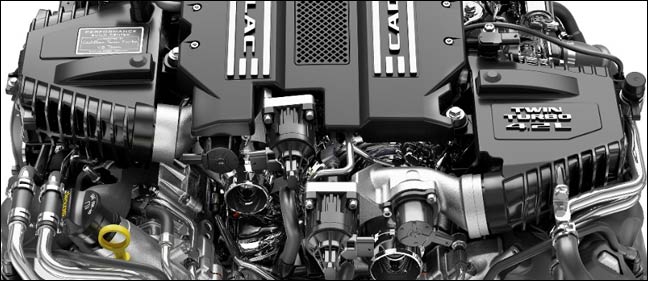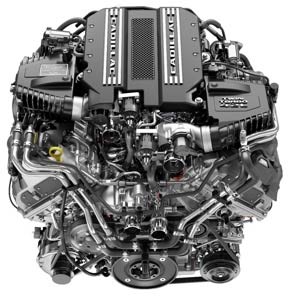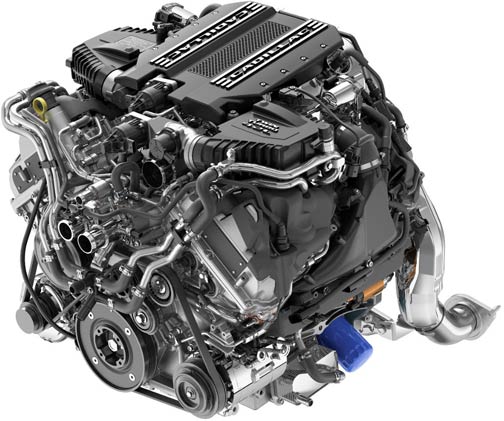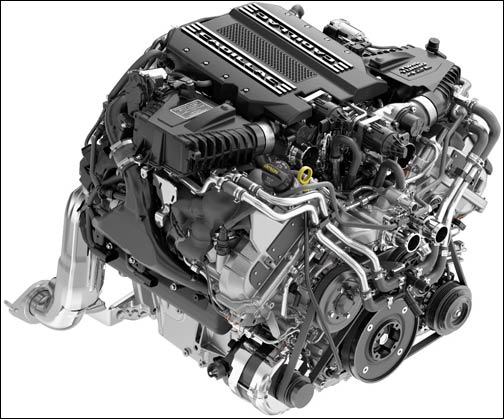
General Motors showed it’s serious about Cadillac today, unveiling a brand new twin-turbo V8 engine pushing out 550 horsepower for its hot V-series cars.
It’s no match for the Dodge Hellcat V8, which has 707 horsepower in normal form and 840 in the Demon, but the new engine— prosaically named “4.2L Twin Turbo V-8” — is far lighter and smaller, and can be used in smaller, lighter cars. The first one, indeed, will be the CT6 V-Sport.

GM estimates its V8 produces 131 horsepower per liter, and generates an impressive 627 pound-feet of torque in the CT6 V-Sport. The base CT6 has a 500-horse version, good for 553 pound-feet.
The company claims that the Caddy motor is a clean-sheet design; its chief engineer, Jordan lee, said that creating a completely new engine was the best way to reach their performance goals.
The “hot V” setup mounts the turbos above the engine, in the valley between the heads, to reduce the overall package size; that also virtually eliminates turbo lag. Most turbo engines take in the pressurized air through top-of-engine ports, while the exhaust goes through the wastegate below. The Caddy has air coming in through the lower outside of the heads and exiting through the top, where the turbos are integrated with the exhaust manifolds.

The same design lets the catalytic converters mount closer to the engine, both cutting package size and speeding light-up ever so slightly.
The engines, to be hand-made in Bowling Green, Kentucky, boast dual twin-scroll turbochargers, electronic wastegate control, dual water-to-air charge coolers (often mistakenly called “intercoolers”), direct injection, and independent dual cam phasing. To increase gas mileage, the V8s will have variable-pressure lubrication, stop-start, and cylinder deactivation.

Unsurprisingly, the block, pistons, and heads are aluminum — a new design for both — with forged steel for the crank and connecting rods. The stroke is 3.55 inches (90mm), while the bore is 3.4 inches (86mm); displacement is 255 cubic inches. The small bore was designed to cut the piston weight for faster revving.
Boost is limited to 20 pounds (1.38 bars); 90% of peak torque is available at just 2,000 rpm, and stays available through 5,200 rpm.
The twin-scroll turbochargers (one for each line of cylinders) have a divided housing, with two exhaust-gas inlets. One nozzle is designed for fast response, the other for peak performance. The separation from the integrated exhaust manifolds/turbocharger housings leverages exhaust scavenging to improve turbine efficiency and reduce turbo lag.
The wastegates are independently controlled on each cylinder bank for balanced output. Each throttle body has a 59mm opening.
The charge air coolers are above the turbocharger housings; the turbos pump pressurized air directly through the heat exchangers and into the cylinder heads. Heat exchangers have their own coolant circuit.
The charge air coolers lower the incoming air temperature by more than 130° F (74° C) — achieving over 80% cooling efficiency with only about 1 psi (7 kPa) flow restriction at peak power.
All this is connected with a ten-speed automatic transmission, boasting a wide 7.39 spread for both better launches and higher highway mileage.

Direct fuel injection, used for years by the General, provides a higher compression ratio — 9.8:1 — because of lower risk of spark knock. Twin camshaft-driven fuel pumps bring pressures of 5,075 psi (350 bar) to the injectors.
Cylinder deactivation, imperceptibly shuts down half of the engine’s cylinders in certain light-load driving conditions to enhance fuel economy; it uses special rocker arms for each of the four valves of the cylinder being deactivated. The block itself is A319 sand-cast aluminum, with pressed-in iron liners — a well proven technology. Heads have 36 mm intake valves and 29mm sodium-filled exhaust valves.
The car has dual overhead camshafts and a timing chain. The dual independent cam phasing allows the intake and exhaust valves to be changed at different rates.
Four oil jet assemblies in the engine wet the underside of the pistons and the cylinder walls with cooling, friction-reducing oil, allowing the engine to produce more power without reducing long-term durability. The engine uses a stunning ten quarts of General Motors’ dexos2 0W40 motor oil.
Power output:
- 550 hp @ 5,700 for V-Sport, 500 @ 5,000-5,200 for CT6
- 627 lb-ft @ 3,200-4,000 for V-Sport, 553@2,600-4,600 for CT6

David Zatz has been writing about cars and trucks since the early 1990s, including books on the Dodge Viper, classic Jeeps, and Chrysler minivans. He also writes on organizational development and business at toolpack.com and covers Mac statistics software at macstats.org. David has been quoted by the New York Times, the Daily Telegraph, the Detroit News, and USA Today.

Leave a Reply